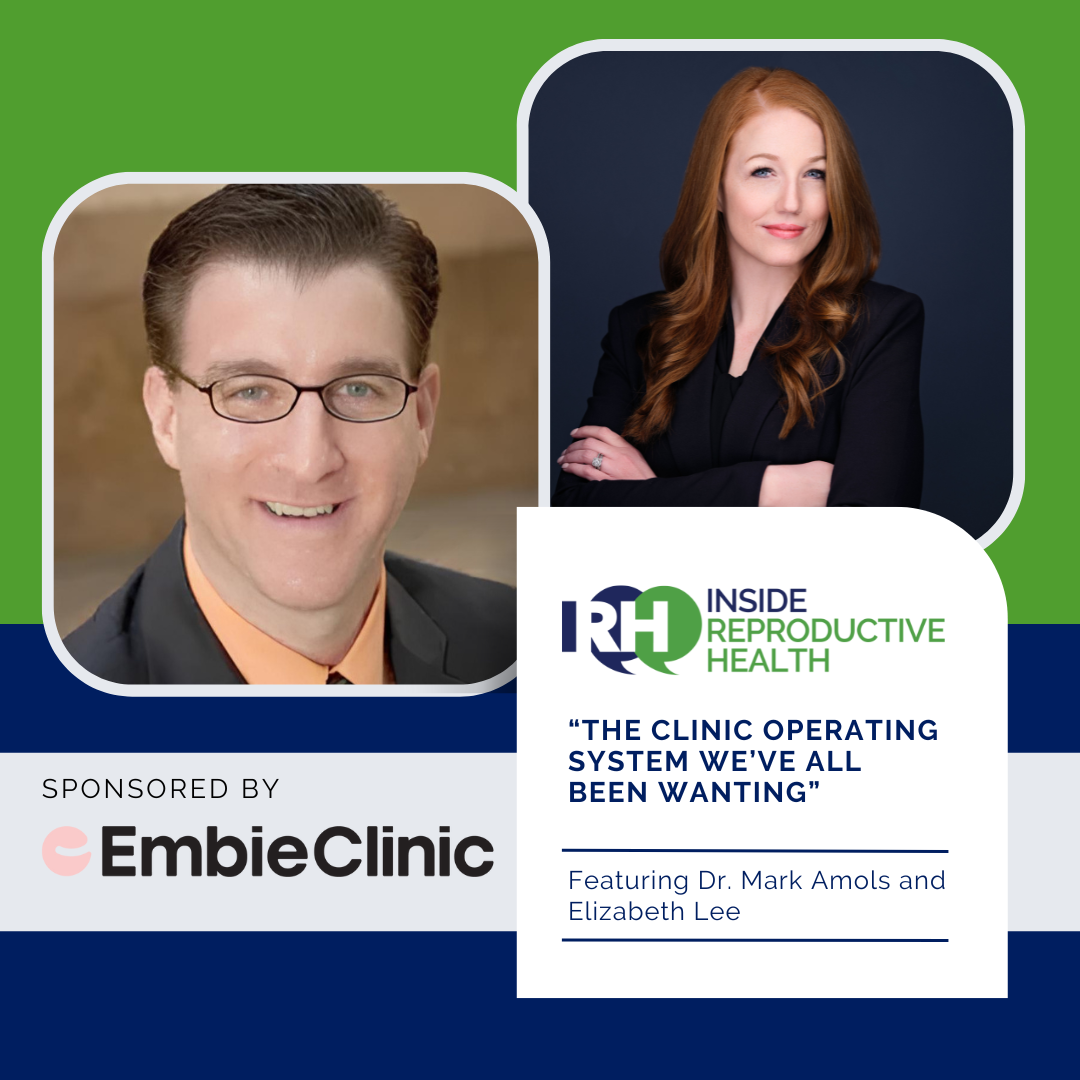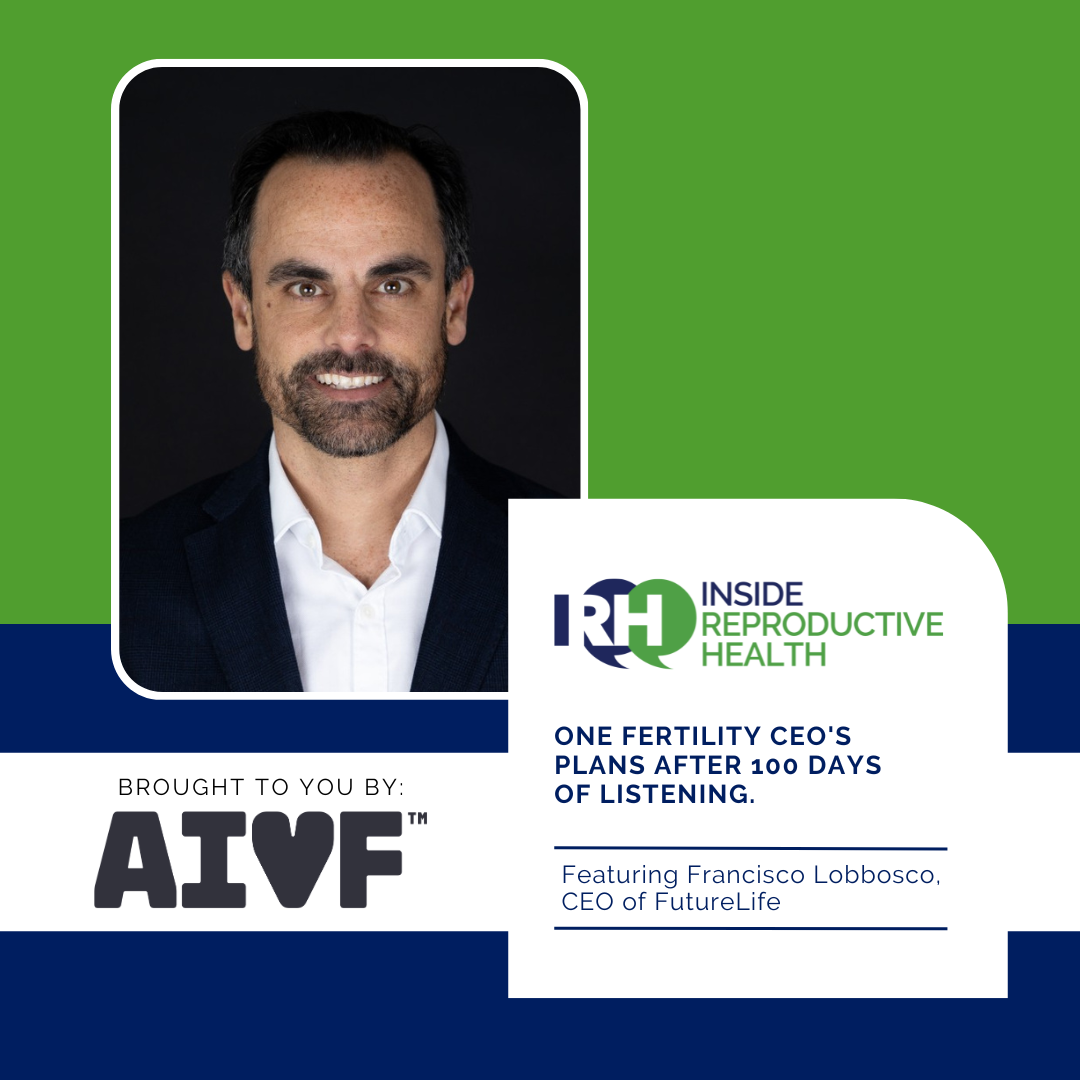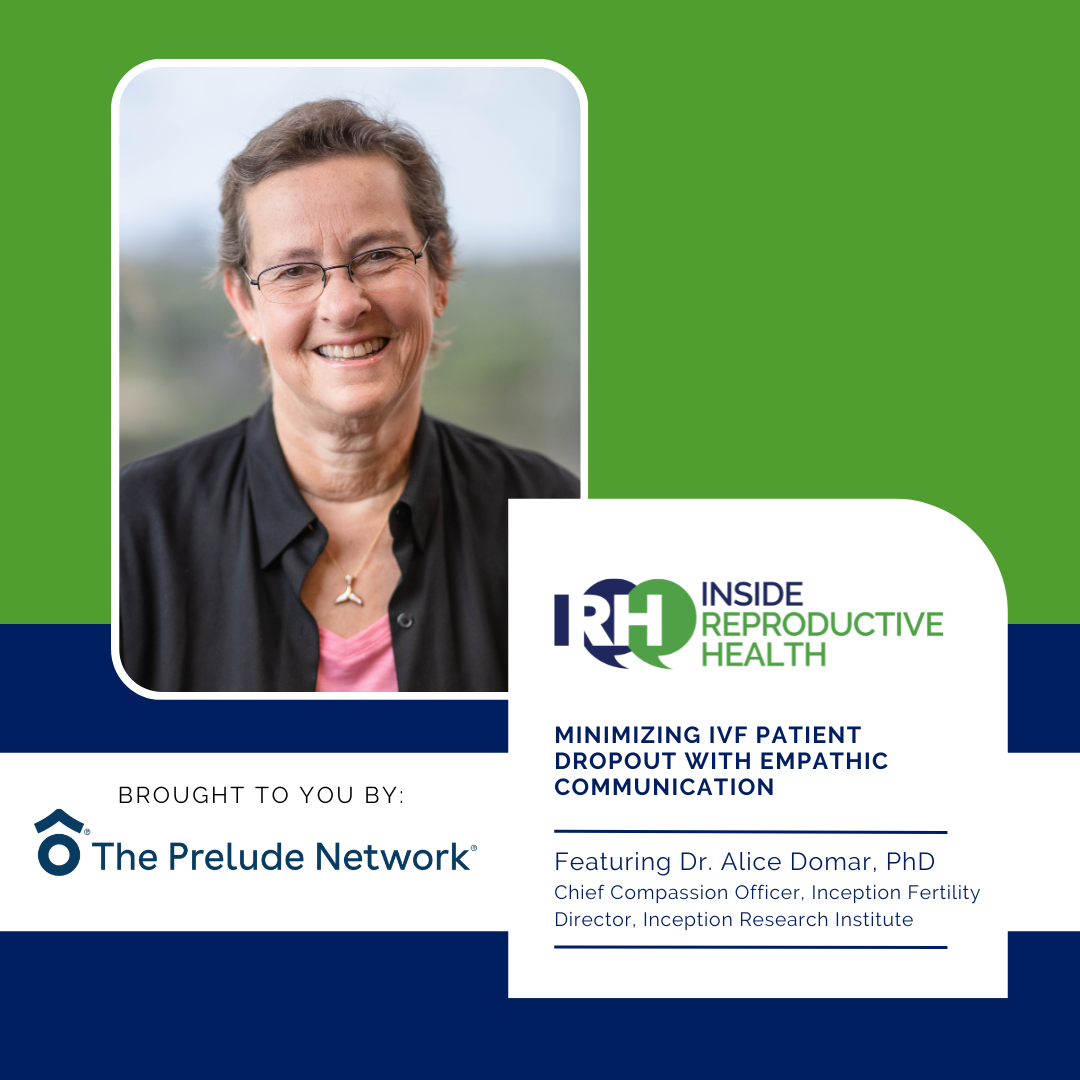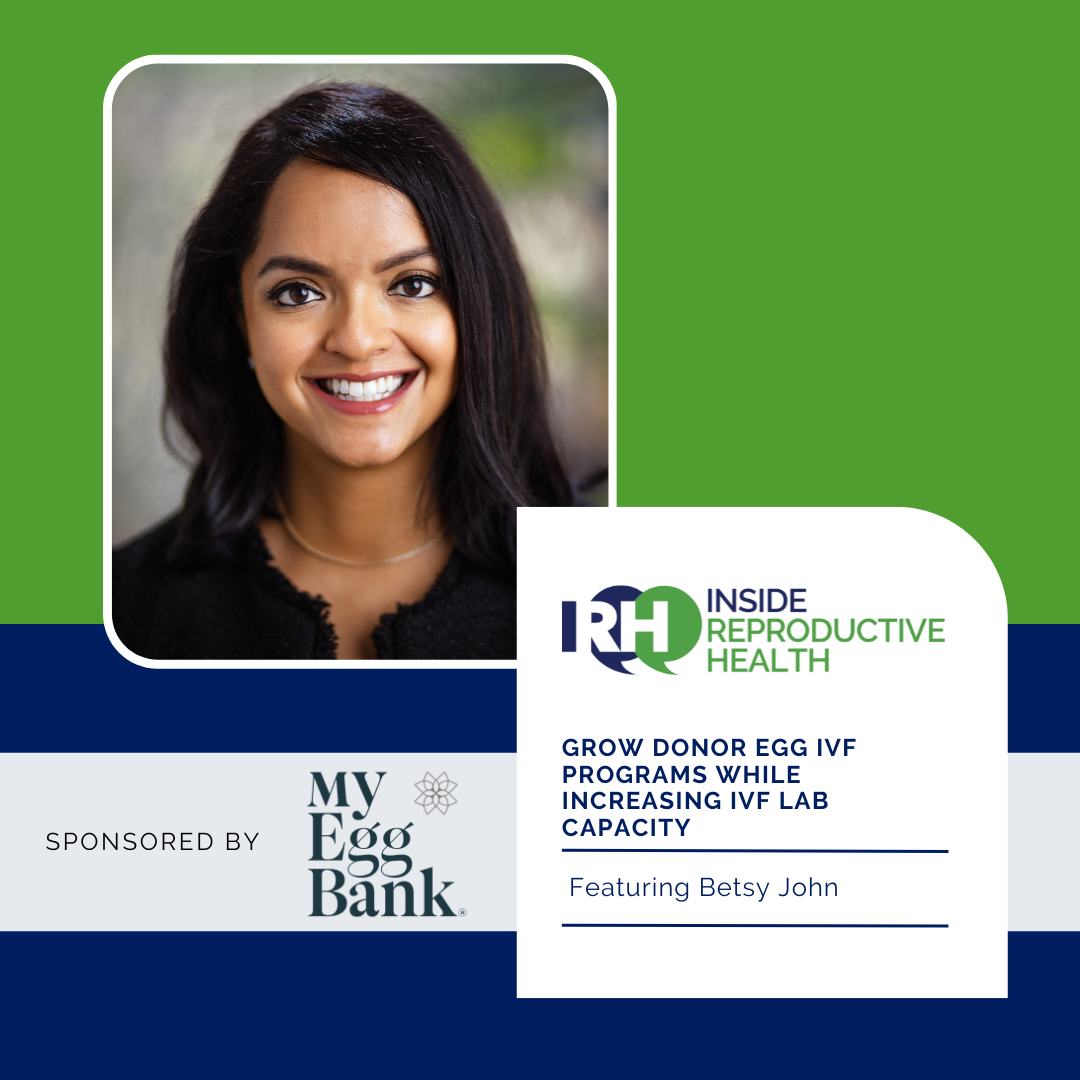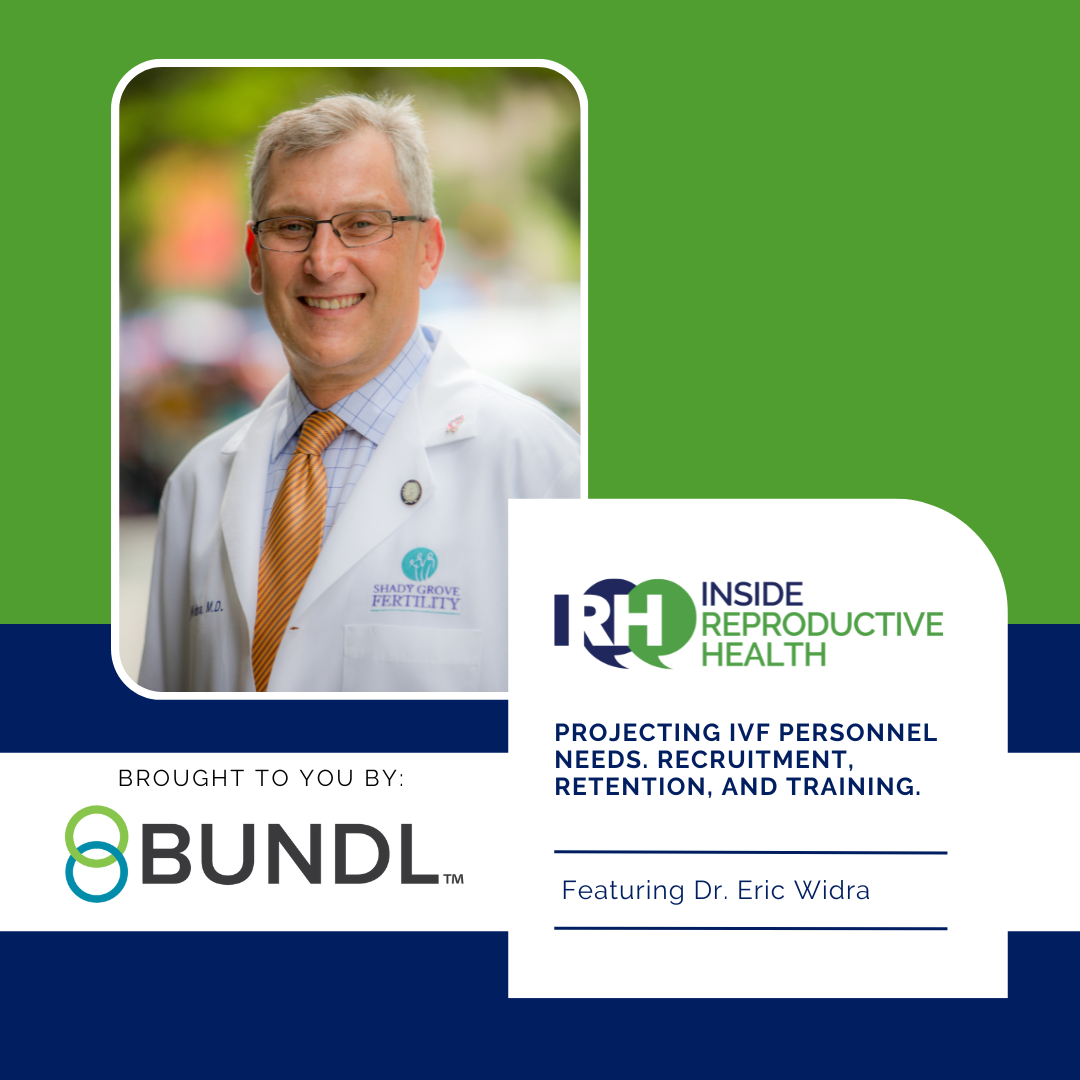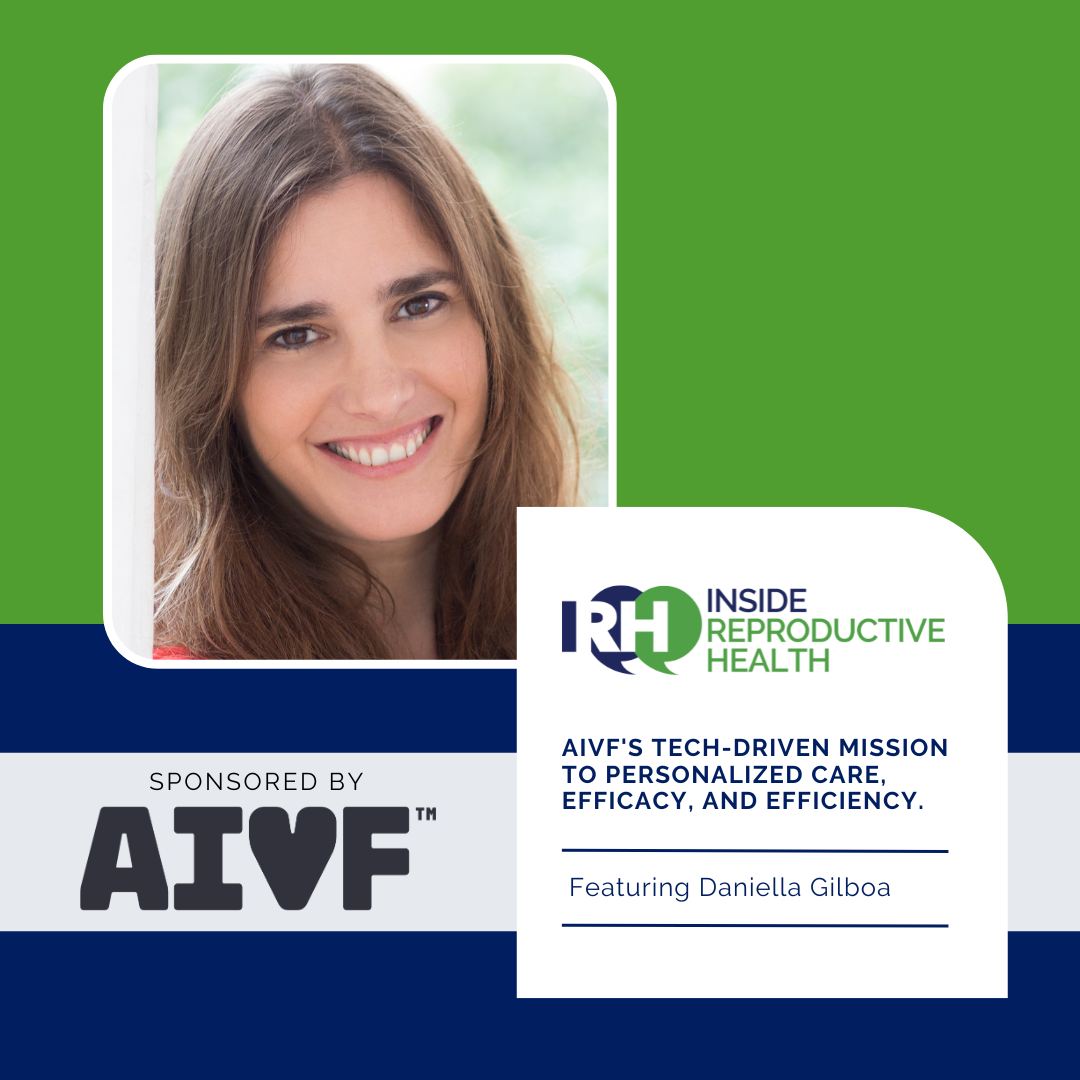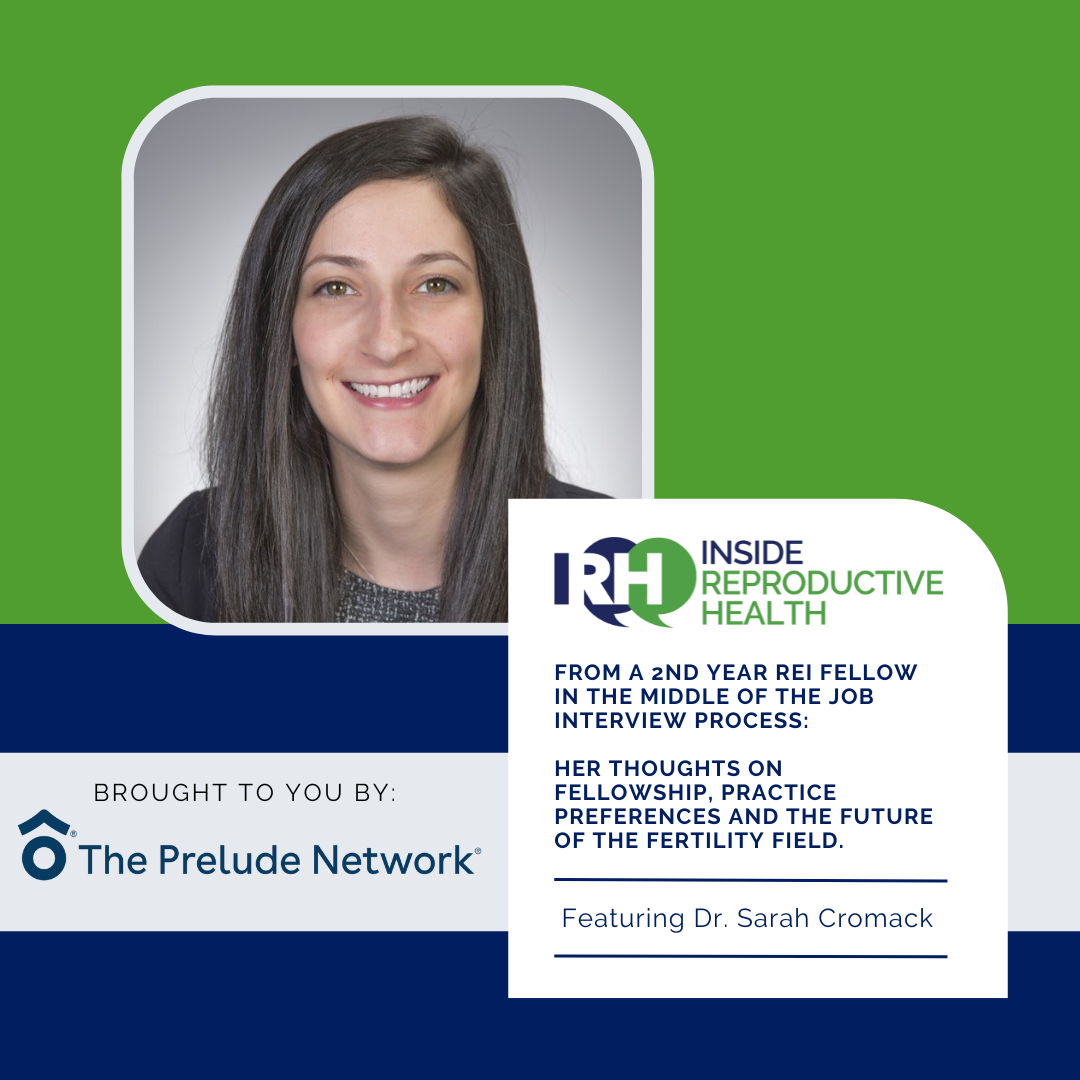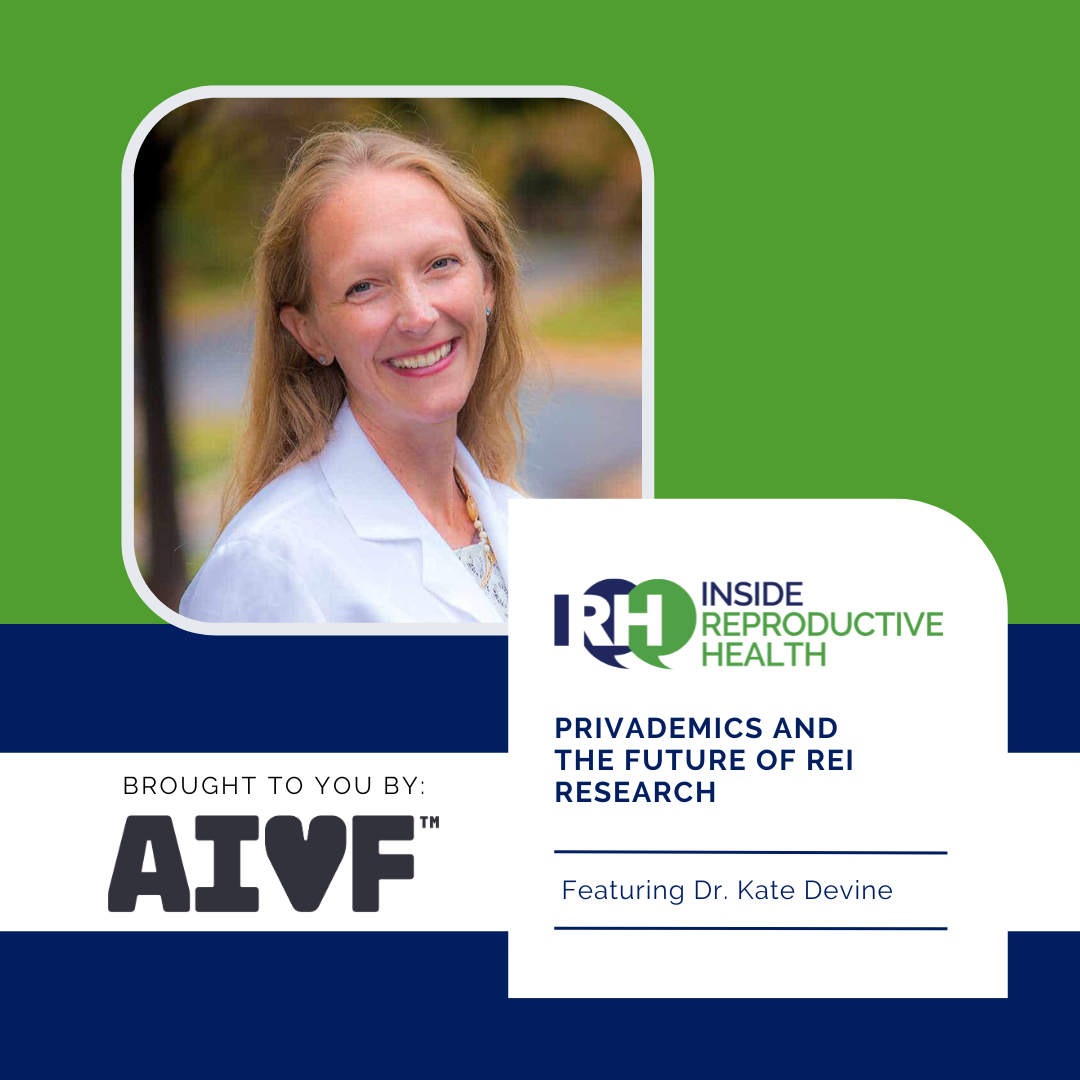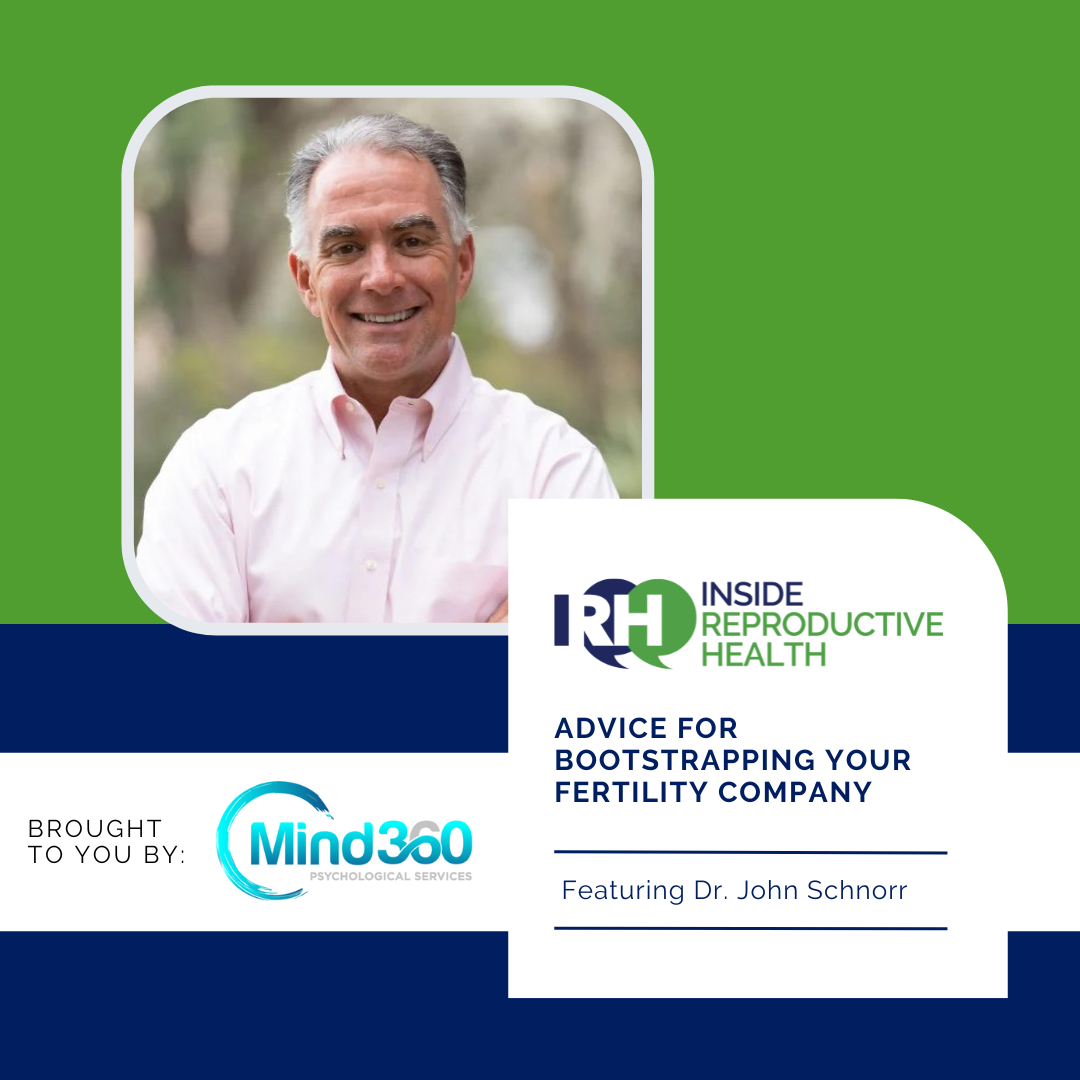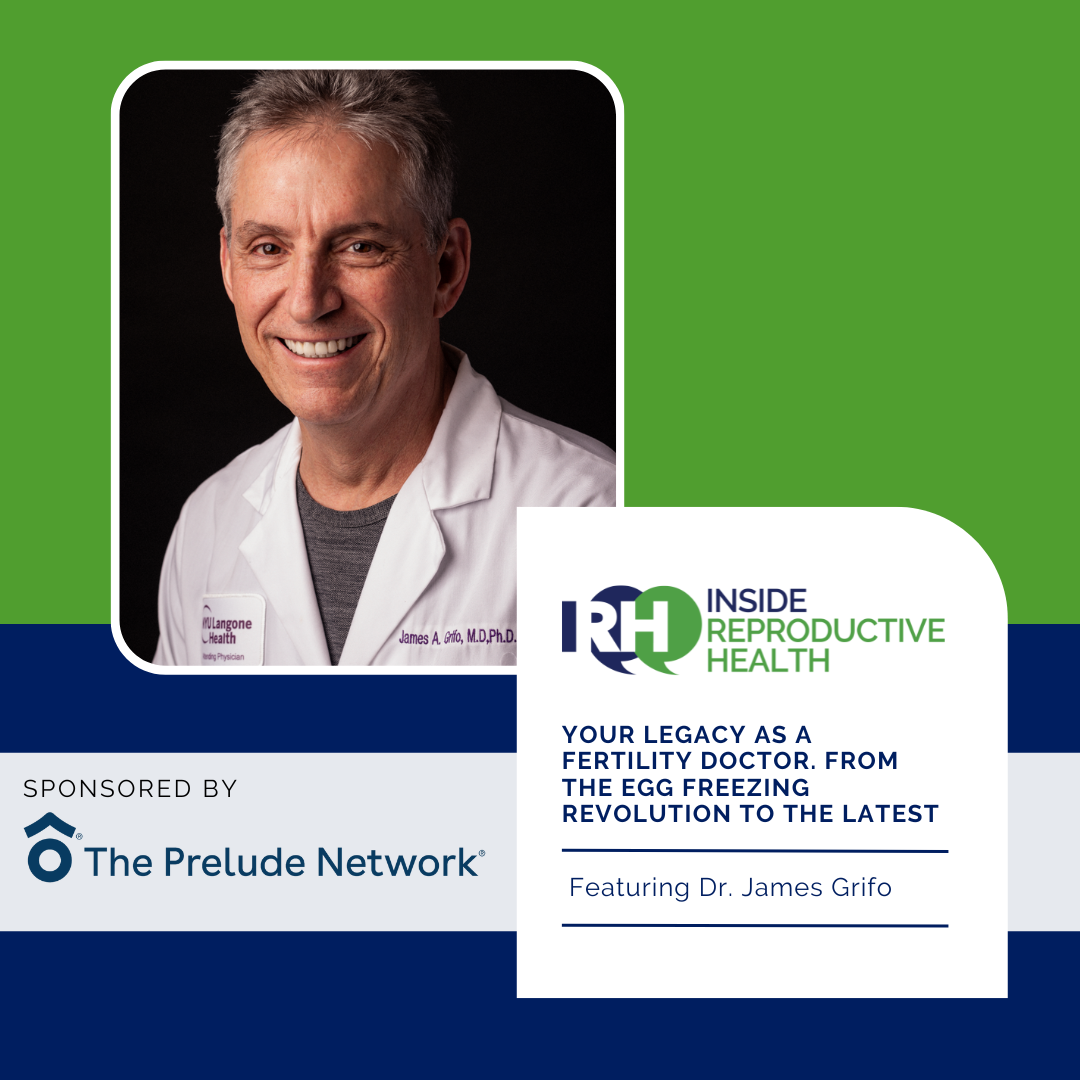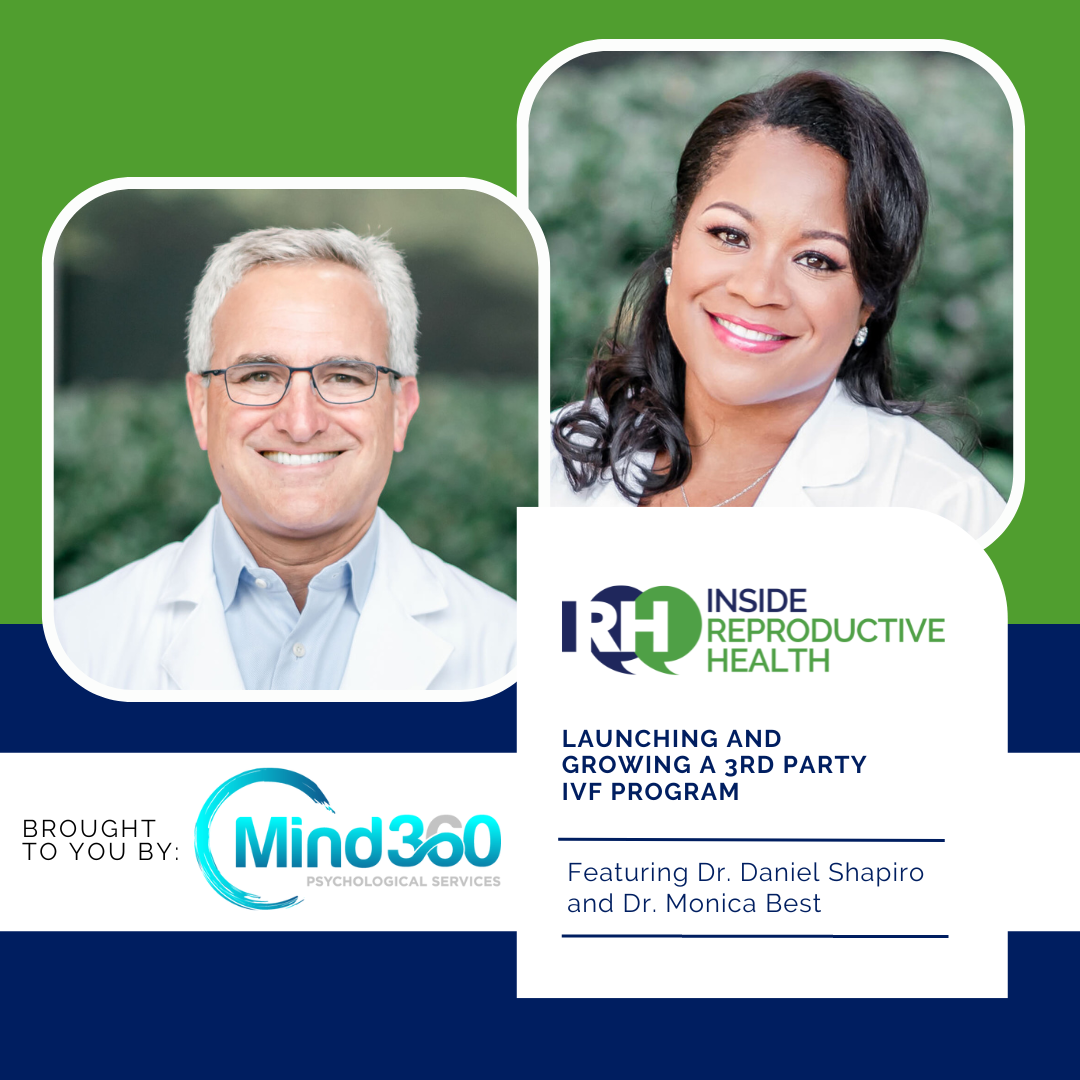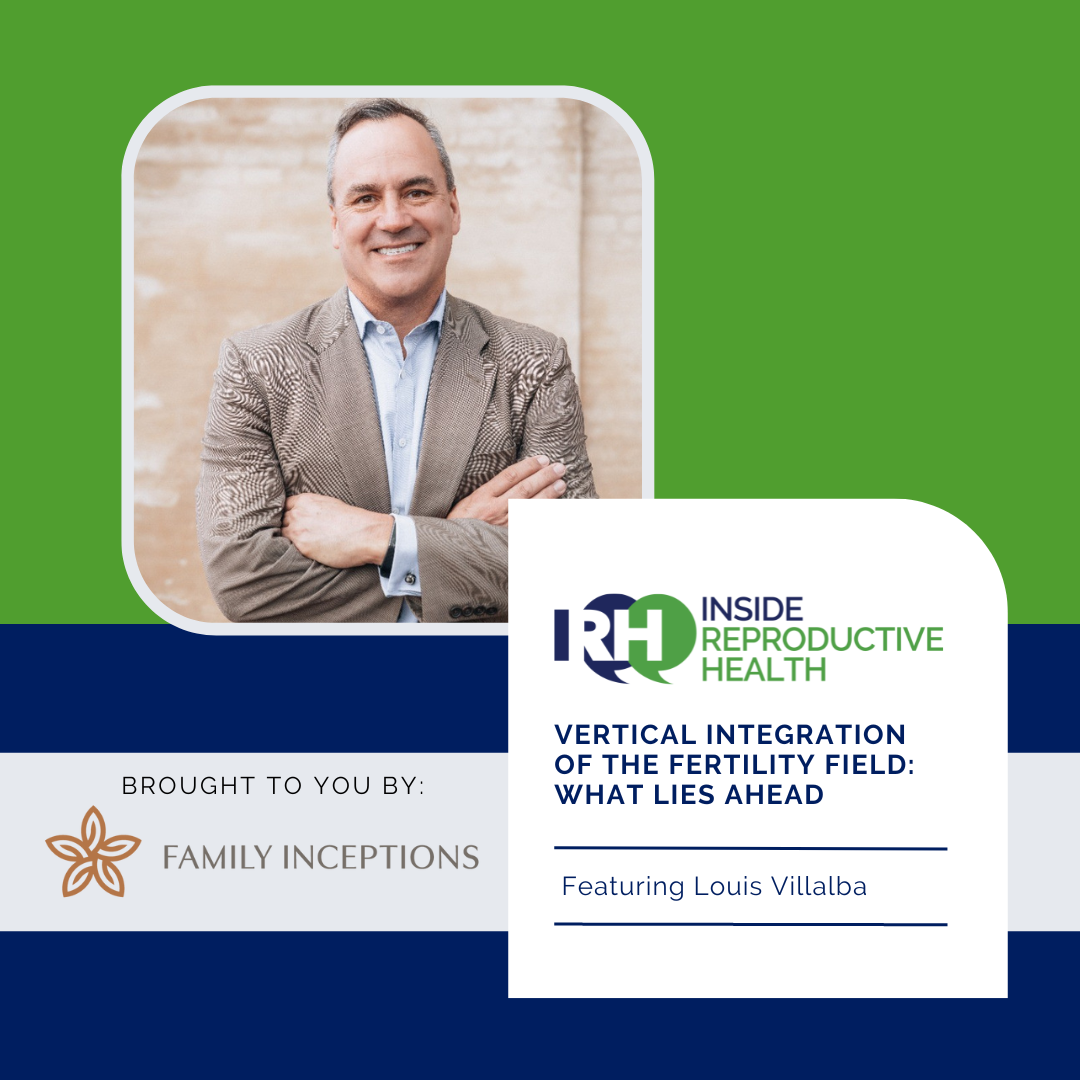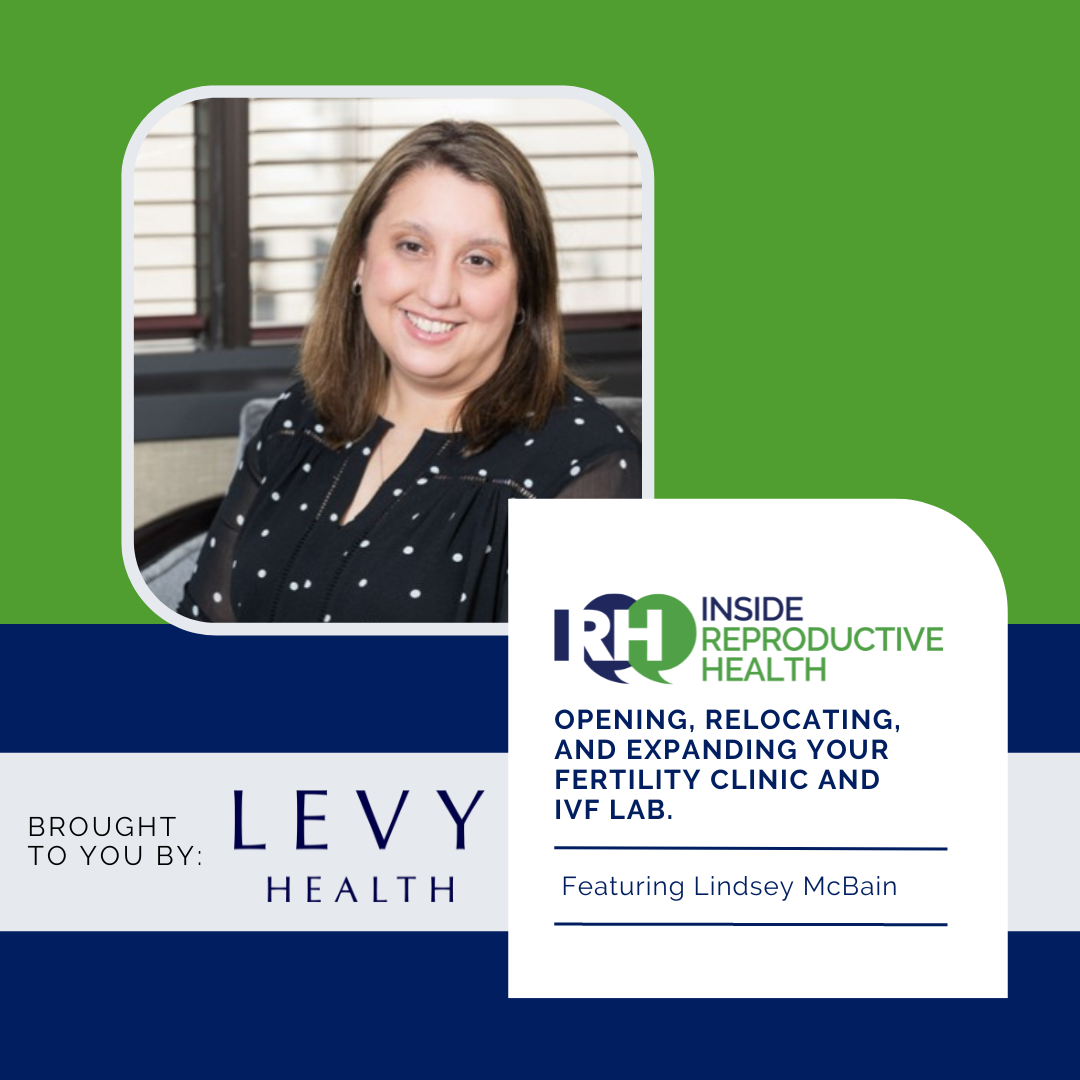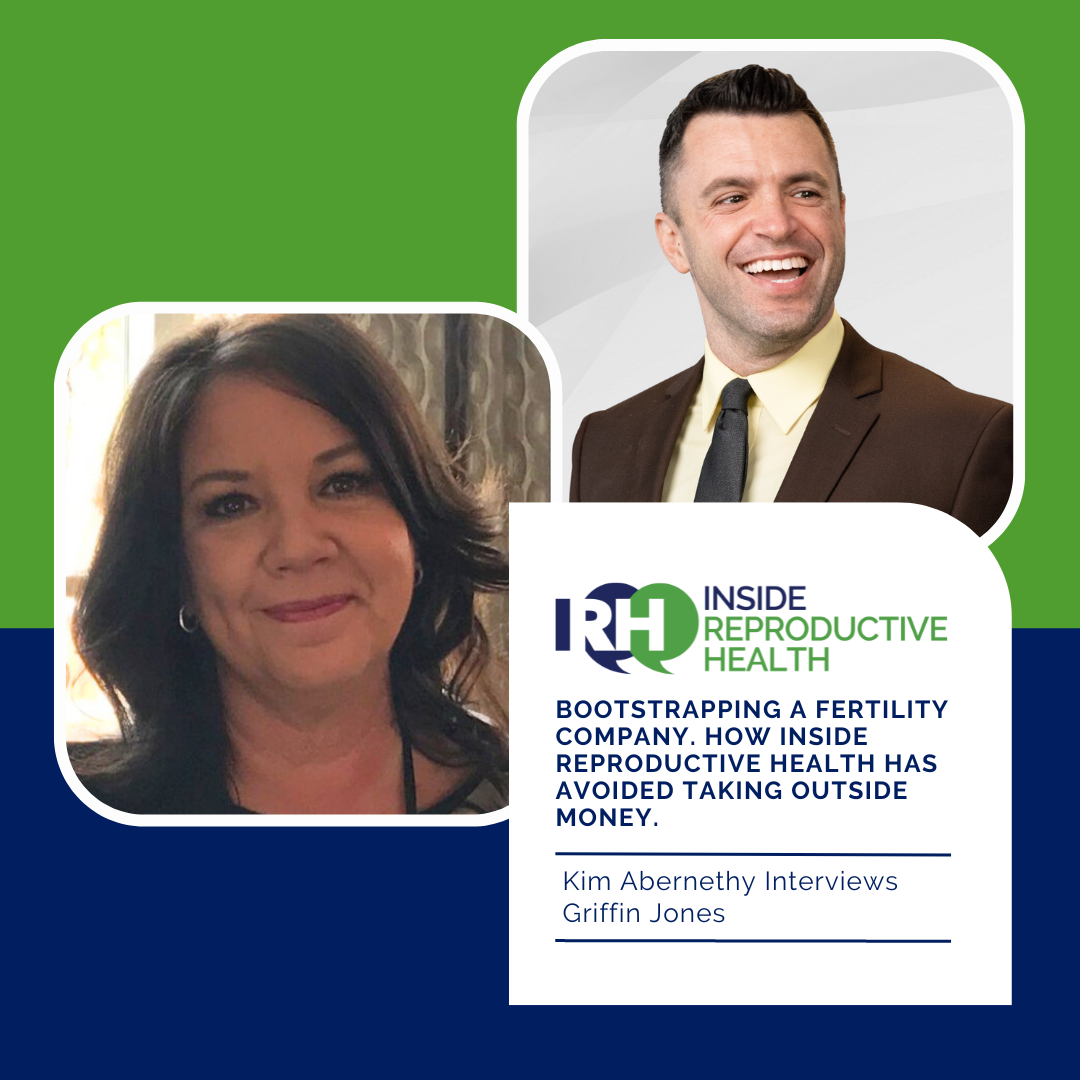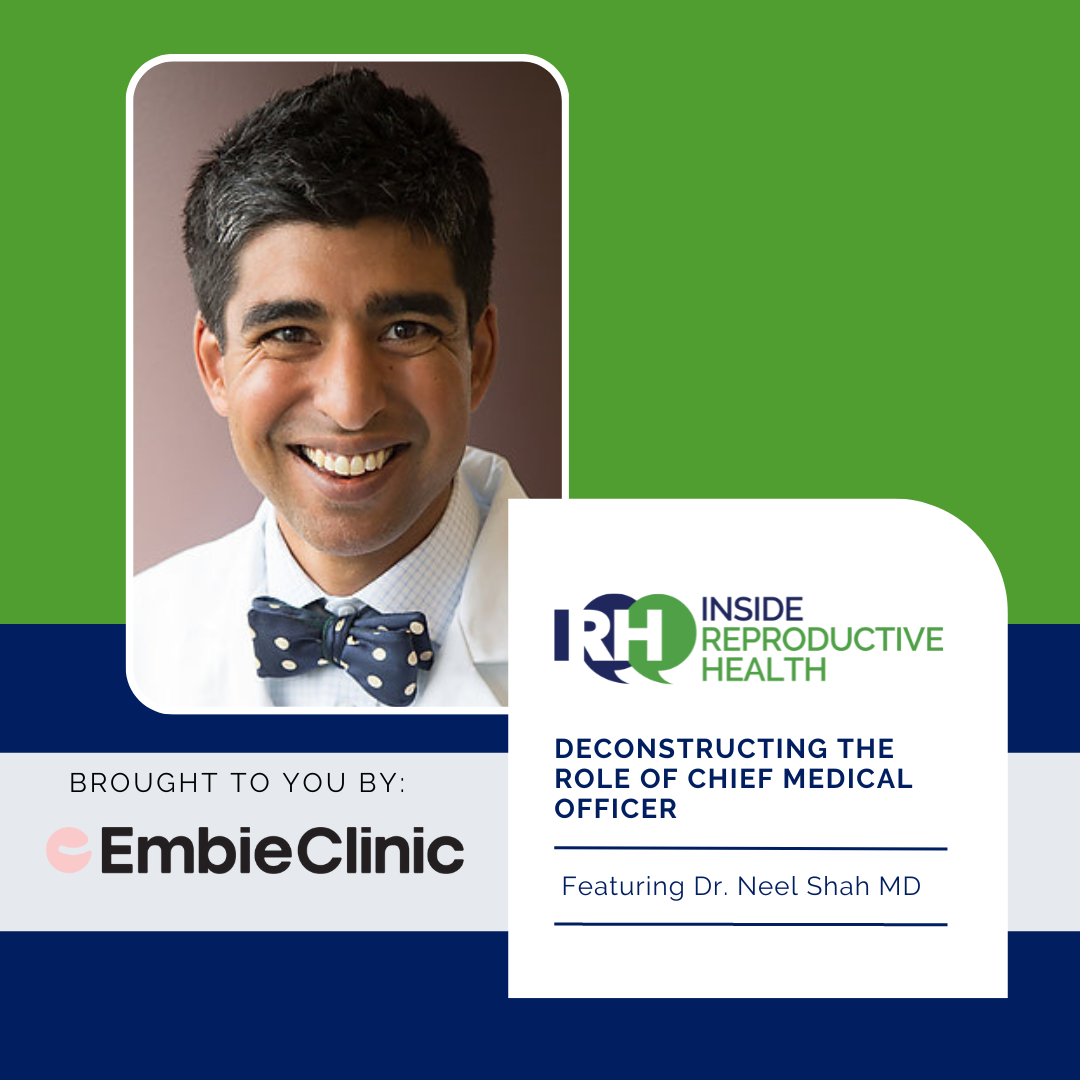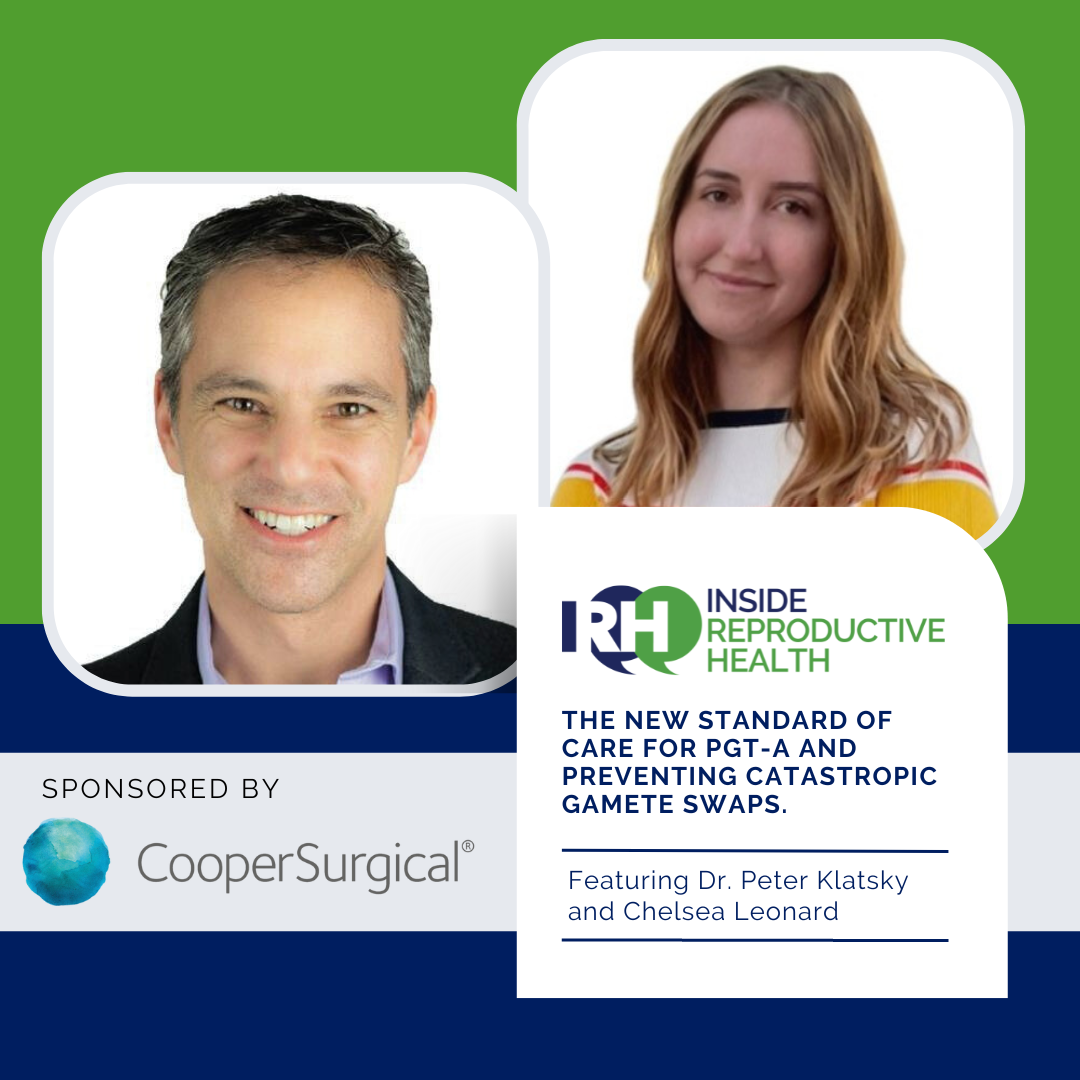DISCLAIMER: Today’s Advertiser helped make the production and delivery of this episode possible, for free, to you! But the themes expressed by the guests do not necessarily reflect the views of Inside Reproductive Health, nor of the Advertiser. The Advertiser does not have editorial control over the content of this episode, and the guest’s appearance is not an endorsement of the Advertiser.
What trends are young REI doctors interested in?
What do fertility practices need to consider when recruiting first year Fellows?
Dr. Morgan Wilhoite, a first-year REI Fellow, provides insight into her career focus and how she's shaping her Fellowship experience to align with her goals.
With Dr. Wilhoite we discuss:
Her areas of learning interest during Fellowship (Valuable for clinics to see the trends for young REIs)
The resources that all Fellows should be consuming to prepare for their ideal careers
Why Privademic might become the default model for young REI career preferences
Advice for clinics looking to recruit young fertility doctors (How to be ahead of the hiring curve)
Dr. Morgan Wilhoite
Instagram
Transcript
[00:00:00] Dr. Morgan Wilhoite: So it's almost like when you are in kindergarten and you look at the fourth graders and you're like looking at what they're wearing and what they're doing. And it's like, I want to be like them one day. That's kind of how the first year fellows I feel like are, are treating this process. We're looking at the third years who are, again, I'll use my analogy, the bells of the ball.
They're getting recruited, they're getting job offers, they're signing contracts. It's super exciting. You're living kind of vicariously through them.
[00:00:26] Sponsor: This episode was brought to you by Prelude Fertility, where top REI physicians find their calling. Practice anywhere with Prelude. The Prelude Network is the fastest growing network of fertility clinics in North America.
With more than 90 plus locations, we're ready to support you and your individual career aspirations wherever they lead. To learn more, please visit rei.preludefertility.com. That's rei.preludefertility.com.
Announcer: Today's advertiser helped make the production and delivery of this episode possible for free to you. But the themes expressed by the guests do not necessarily reflect the views of Inside Reproductive Health, nor of the advertiser. The advertiser does not have editorial control over the content of this episode, and the guest's appearance is not an endorsement of the advertiser.
[00:01:22] Griffin Jones: You're welcome, people who are trying to recruit fertility doctors. I got a little bit ahead of the curve for you. I went out and found a sharp, engaged, first year REI fellow. And I asked her about how she's trying to influence her fellowship to design her career. Dr. Morgan Wilhoite might be a focus group of one, but pay attention to what she's paying attention to.
And if you're an REI fellow thinking about what kind of career you want after fellowship, or you're an OBGYN resident who's interested in going into the field of REI, you should pay attention too. Because we uncover advice to make sure that you're getting a proper cross section of people to talk to.
That it isn't just the kindergartners looking up to the fourth graders. To paraphrase Dr. Wilhoyt, we talk about particular resources that you should be consuming to get smart about how you're going to build your REI career. We talk about the particular areas of interest. Dr. Will Hoyt is interested in learning more about and fellowship, which I think is of value to you.
So that you get an idea of the trends of what it is that these young REIs want to work on. And we also talk about why Privedemic might become the default model for young REIs career preferences. Based on Dr. Wilhite's experiences, I give some advice to those that are recruiting young fertility docs, how to get ahead of the curve and not just being a dead dash to the finish when it comes to contract time.
I hope you enjoy this fun, lively conversation with Dr. Morgan Wilhite. Dr. Will Hoyt Morgan, welcome to the Inside Reproductive Health podcast.
[00:02:49] Dr. Morgan Wilhoite: Thanks Griffin. I'm so excited to be here.
[00:02:52] Griffin Jones: It's been a while since I've had a first year fellow on the program before. And I've, I've had many different fellows at different points.
Probably most of them have been second or. or third year and sometimes the reaction is like, well, why are you having fellows on? What do they know? Like, what do they know yet? There's a reason why I do it. A couple of different reasons. I think it's always useful just to constantly stay abreast of what it is that people are interested in, what they're up to.
And most of my audience is recruiting. REIs, and there are, they're either recruiting REIs or they're younger REIs that are thinking about the next phase in their career. And, and so maybe you can't advise those folks, but, or maybe you can, maybe there's, maybe there might be a nugget that, that helps them, but it also helps the folks that are thinking about the docs that they want to recruit, that they want to have as part of their team, not just for next year, but staying on the pulse of what the upcoming class of fertility physicians is interested in, I think is important.
And so I'm interested in now that you are, we're recording this in January of 24 where, which makes you halfway through your first year of REI fellowship. What did you set out to accomplish in your fellowship? In a, in a, I'm obviously studying the subspecialty, but like, what did you want to use it to frame your career?
[00:04:18] Dr. Morgan Wilhoite: It's funny that we started out, started out here because when I was preparing for REI interviews, I actually came across My file of all of my video recordings, where I was kind of talking to myself, interviewing myself about how I was going to answer certain questions. And I started rewatching them just out of curiosity while I was preparing for this.
And I realized, you know, I'm, I'm halfway through first year and I'm still relatively bright eyed and bushy tailed when it comes to being an REI fellow. But I was even more so when I was preparing for these interviews, I found myself just All over the place. I was wanting to do an MBA while online while I was pursuing fellowship and wanting to do, you know, the, the reproductive surgery scholars track and wanting to do some sort of a track where I did genetics incorporated into it.
And I, as you can see, I was kind of like all over the place. I wanted to do everything.
[00:05:20] Griffin Jones: Um, luckily this is when, this is like, as you're applying for fellowships, this is like third year of residency, Yeah. Okay.
[00:05:27] Dr. Morgan Wilhoite: Yes, exactly. I found myself just, you know, wanting to do everything REI. So it was funny to watch that back now since I'm a year and a half, two years out from that.
But when I now think about what I want to get out of fellowship, I'm really not only wanting to be a well trained REI and with that lately comes with the bread and butter IBF, right? That's what most RAIs are doing, but I am at a program where it's very academic and we are still seeing a lot of Bread and butter endocrine.
So we're doing a lot of hypo hypo. We're doing thyroid disorder. We're doing a lot of PCOS patients. So a good majority of our patients that we see are not actively trying to get pregnant. So I think that I am in a unique situation at this program where we're not just doing a million IVF cycles a year.
We are very busy with IVF, but we're also seeing general GYN and endocrinology. So I think getting out of fellowship, I want to be a well trained patient. reproductive endocrinologist. So I want the full scope of endocrinology and the infertility side of things. Also, I want to, you know, as, as much as I wish I could say, I want to be a full time researcher.
And I listened to your podcast episode with Dr. Devine about private MX. I do want to still incorporate research into my practice in some way. working with residents or fellows, probably more in the private and mixed setting, but you know, it's ever changing and I am still a first year. So I guess to answer your question, there are a lot of different avenues that I want to take to get really just the full scope of REI out of my fellowship.
[00:07:15] Griffin Jones: When did you start to pair back these really broad interests that you had? Like, like, how much do I want to to delve into genetics? Do I want to get an online MBA? When did you start to pair that back?
[00:07:31] Dr. Morgan Wilhoite: Great question. When I realized that doing all of those things was not not possible. I, I always joke, I need like 10 more hours in every single day.
And you really do realize once you start fellowship that you're not really a master of none, you're a master of one, and you are super specialized in this field, which is one of the things that I love about it. So I'm realizing now the further I get into fellowship that I, I really want to find my and figure out what it is that I'm going to be.
doing on a day to day basis. And unfortunately that can't be everything. Um, that's just not realistic for, for any person to do all of those things.
[00:08:14] Griffin Jones: But when did that happen? Is this like, like after you started fellowship, you're like, Oh, maybe I won't get my MBA right now.
[00:08:23] Dr. Morgan Wilhoite: Once I realized how busy I was in fellowship, which was surprising, I guess I thought that I would be less busy than residency, but I think I find myself working harder.
More cerebrally than I did in residency probably once I started you might be it's well
[00:08:41] Griffin Jones: You made so you made an important caveat with cerebrally in that you're not doing the same number of hours Presumably as residency, but you're you might be the first person that I've heard say that I'm working more in fellowship than I did and in residency talk more about that
[00:08:58] Dr. Morgan Wilhoite: Yeah, so in residency, there's a lot of doing.
There's a lot of checking on laboring patients and actively managing patients that are in the hospital. But in fellowship, there is a lot more thinking that's involved than it was in OBGYN residency. In residency, you kind of react to situations that come at you, whether that's through triage or patient support.
Changing their status on labor and delivery or in the med surg after surgeries, but in REI, it's a lot more planning ahead talking to patients about their future cycles or previous cycles, talking them about their embryos that are currently frozen, working through the things that They feel important for future family building and less of reacting.
So it's, it's more thinking, it's more preparing ahead of time.
[00:09:56] Griffin Jones: So the fact that you started to, to realize, okay, maybe some of these other things will have to come later. Right now, my focus is going to be on the full scope of endocrinology and fertility. That suggests to me that that was not revealed to you during the, Interview process in the application process.
Why am I inferring correctly? And if I am, why is that the case?
[00:10:22] Dr. Morgan Wilhoite: I think that when you are interviewing for any kind of a job, you start just thinking of all the possibilities of things that you can do. And I wouldn't say I was misled at all, but I was definitely. You know, just starry eyed thinking all of what the future has to hold and offer.
And it does have those things. You just really have to narrow it down and find a niche because being the person, the go to person on genetics, being the go to person on reproductive surgery, the go to on all things IVF, on endocrinology, on the, the, the. The business side of medicine, it's impossible to do all of those things, but very aspirational of Morgan two years ago when she thought she was going to be able to do all these things in one career.
But it's been kind of fun to see the things that I, that I thought that I could do one day and now kind of see the things that I want to do one day.
[00:11:25] Griffin Jones: I'm going to put you on the spot with a question that I'm going to start asking everybody when we start talking about this topic, because I wonder if it's time, but what you're talking about really is the, this tendon, the trend that all fields of medicine and most sectors of the economy are moving to where the specialty becomes subspecialty, which becomes subdivided specialty and ad infinitum, right?
And, and so I wonder when We live in that type of world, should we still be having, should we still be sending 18 to 22 year olds to undergrad as a prerequisite for medical school? What do you think about that? I know I didn't prepare you for that. We didn't talk about that at all, but I'm just, I'm curious in, in what you think.
[00:12:16] Dr. Morgan Wilhoite: Love that question. I think about this all the time, actually, because in medical school, let me even go further back. In high school, it's, really hard as an 18 year old to say, you know, I want to be a doctor in general, let alone like what kind of doctor you want to be. Right. So I do think there is a period of growth that going to college and getting a bachelor's degree has, there's perks to that, right?
You, you grow a lot in college, you realize what you want to do. You kind of, live the, the fun part of your life that you never really get back that, that freedom of just exploring. So I think there is a place for it for sure, but there are a lot of years between high school and fellowship where I feel like things could be narrowed a bit.
One of those is I will die on this hill, but fourth year of medical school. Everyone knows that fourth year of medical school, you're kind of just hanging out. You're doing, you know, what you want to be doing. You're ending your year on rotations where you can, for lack of a better word, chill, because you've already taken step one.
You've already applied to residency. You probably already matched into residency. So I do think fourth year of medical school is a little bit overkill. It's kind of a very expensive vacation, so to speak, at least the second half of it. And then you go to residency, and this is another probably hot take on my end, but for OBGYN residency, I spent, you know, four years delivering babies, doing hysterectomies, doing the bread and butter OBGYN stuff.
And Didn't do, you know, any REI besides my couple, my one required rotation and then the additional things that I sought out because I wanted to pursue REI as a field. So I think that OBGYN, Eventually, I know there's been discussions of it so far, but becoming more of tracks into either the GIND track or the OB track, because while I think it's important that I know how, knew how at one point, to deliver a baby, am I ever going to be delivering babies as an REI?
No. And I spent four years. you know, perfecting that skill and doing thousands of deliveries. So they're a long answer to your question that I really, really liked was there's a lot of where places where you can kind of dial back on how much training you need to do this career. Yeah.
[00:14:48] Griffin Jones: And I'm, I'm, the reason I asked the question, even though it's kind of a bit of a digression is I think it plays into how you're deciding what you want to do next with your career.
And at this point in your fellowship, you decided, okay, I've had to be broader in these different, I had to be more broad in residency, delivering all these babies. I had to have all these different rotations for the. your medical school when I already knew what I was going to specialize in, et cetera, that there is a spectrum of where we need to build a rudimentary foundation for different areas of medicine, but then we might be staying in that rudimentary phase.
for too long and not moving and wasting time where we could be specializing, especially when we need to further sub specialize and then further subdivide sub specialties as the field advances and gets more complex.
[00:15:52] Dr. Morgan Wilhoite: Yeah, exactly. I mean, I'm full disclosure. I'm 32 and I'm very early on in fellowship. So I'll be 34 when I graduate and I will be looking for my very first job at 34.
And then there will be times in my career where I want to maybe do something a little bit different and further subdivide as you described it. And I could be in my mid forties or even 50 when that happens. And you really spend so much of your life leading up to this career that you've worked your whole life for.
And maybe by that time, your career that you've worked so hard for that you found your niche might only be 10 years after that, if that.
[00:16:33] Sponsor: As pioneers in reproductive health care. Prelude Fertility invites you to join an extraordinary mission to transform the way fertility treatments are delivered. What sets the Prelude Network apart?
It's the people. We're home to some of the most skilled and compassionate fertility experts in the industry. Prelude Fertility doctors have been recognized with numerous prestigious awards, including Top Doctors, America's Top Obstetricians and Gynecologists, and many others. Our culture is one of collaboration and shared knowledge, where learning from each other is just as important as learning from our experiences.
Prelude's facilities are a testament to innovation, equipped with the most advanced tools in reproductive science. This means you, as a fertility specialist, will have everything you need to provide care that's not just effective, but transformative for the fertility field. The Prelude Network is the fastest growing fertility network in North America, with over 90 locations.
This growth isn't just about numbers. It's about providing you with the flexibility and security to build a career that aligns with both your professional and personal aspirations. The impact you'll have at Prelude is profound. We've helped bring over 165, 000 babies into the world, and each day offers a new chance to change lives.
Your expertise and care have the power to turn hopeful dreams into joyful realities, crafting stories of hope and family. So why join Prelude? Because here, you're part of something bigger. You're at the forefront of a movement that's constantly evolving, pushing the boundaries of fertility care. Together, we can shape a brighter future for families and set new standards in healthcare.
Discover how you can be part of what's next in fertility. Visit rei.preludefertility.com and take the first step toward a career that's as fulfilling as it is trailblazing. That's rei.preludefertility.com.
[00:18:46] Griffin Jones: Do you think with regard to finding that first job, do you think about it in those terms with your fellowship that I am trying to craft what I want to get out of that first job?
It's going to be the first time where I'm not. Uh, uh, applying to, to residency and getting, getting matched somewhere and fellowship match somewhere. I get to actually have some agency here. Do you think about how you're setting up your, your first job or do you look at, Your fellowship more generally and saying, well, this is what I want to study.
This is the knowledge I want to get. And then the job will come later.
[00:19:25] Dr. Morgan Wilhoite: I think both. I like the word that you said agency there, because this is a weird feeling. I don't know if I would describe it as weird, more just. I've never been in this position before where you're not trying so hard to prove yourself to get to the next step.
You know, all through high school, you're trying to get into a good college. Through college, if you know you want to go to medical school, you're trying to do everything to put you, yourself in a good position to get into medical school. Through medical school, you're putting yourself in that position to match into a good residency, and then through residency, same thing, to get into fellowship.
So there's all these, I like to call it, leading a life of contingency. It's like, I will get to the next step and be happy when I'm an REI fellow. And now I'm kind of at that stage where it's like, okay, I've, I've gotten into all of these things that I've strived to, to get into the place that I am now.
And now I get to really learn and craft my future the way I see it and the way I want to do it. And it's, An odd feeling because I've never gotten to do that before. I've always been trying to do the things to make me look perfect on paper for the job that I eventually want. And now I definitely have to rearrange my mindset to think, Okay, what, what can I do now to put myself into the best position to be the doctor that I want to be, to work at the practice that I want to work at?
Because now it's going to get to be my choice where I want to go and what I want my niche to be.
[00:20:58] Griffin Jones: To what extent is the first year are you able to shape your education to prepare of how you want to To practice in the future.
[00:21:07] Dr. Morgan Wilhoite: Yeah, so I think I'm I'm lucky at my program because our my attendings It's kind of a close knit program.
We have Three will now four full time faculty and they work really closely with you So you can get out of fellowship what you feel like you need to get out of it to do what you want to do Of course, I'm at an academic program and I wish more people wanted to go into academics and I do and I love it But there are other things of course that I'm interested in and I feel well supported to do that For instance, my program is set up where I?
The first six months, you're kind of learning the ropes from the, what we call the IVF fellow. So you're learning kind of how cycles go. You're doing more of the low tech stuff, ovulation, induction, IUIs, and then you're also rotating through outside, um, services. So for instance, I rotated my first six months through adult endocrine Through pediatric endocrine where I did a lot of Turner syndrome clinics and transgender medicine I did DSD clinic and We do some genetics in there, too And then I was actually told by my program that if I found something else that I was interested in learning more about I if I could, you know make that connection and set that up for myself and it would be helpful for my future career, then I was encouraged to do that.
So I spent a considerable amount of time with peds endocrine because I was very passionate about fertility preservation and those populations oncofertility and then pediatric like Turner syndrome and Coleman's and the transgender clinics. So there were things that I was given a lot of autonomy on being able to explore further.
And I feel very lucky to have had that opportunity in my program. And then once January of your first year hits, you are the IVF fellow for 12 months. So it's you in the, in the clinic every day, doing the retrievals, doing the transfers, and it's less, more structured, less, You get to choose what you do, but to answer your question, there is a little bit in there your first year to get to explore and kind of tweak how you want your career to look and explore that.
But then yes, once you become IVF fellow, it's much more structured, which I think is a good, a good mix.
[00:23:30] Griffin Jones: Is that to say that in your career, you want to be, you want to either be researching more and more of the latest in endocrine or, or that you want to be focused more on, on endocrine patients as opposed to doing IVF?
[00:23:49] Dr. Morgan Wilhoite: Not necessarily, but I want to have a lot of that background knowledge to be able to do some of those fertility preservation cycles for patients that have like Turner's mosaic or Oncofertility and I think because I was able to explore that so much in my first six months I now have an idea of what that would look like in a future practice taking a those patients and especially the pediatric patient population.
There are some centers that don't do a lot with fertility preservation for the pediatric population for various reasons. So I think being able to explore those different things in endocrine and the different genetic things are, were definitely aiding to the ability to kind of Figure out what I want to do later on
[00:24:38] Griffin Jones: right now is privademic at the top of your list.
If you're thinking of practices in general categories, academic or independently owned or part of a network or private Demick is, is that at the top of your list?
[00:24:51] Dr. Morgan Wilhoite: I think so. And again, this is, you know, I'm still in that. starry eyed first year fellow thing where I'm, I could see myself doing a lot of different things, but definitely being able to, um, to mentor and teach on a medical student level, resident fellow level.
I want to be involved in education. Um, and in doing so, I wouldn't like to be involved in those, um, different levels of research, um, helping medical students, um, Residents and fellows get research projects off the ground, helping them kind of understand how to read research. All of the things that my mentors have done for me getting to this point.
So, Privademic seems like kind of the way of the future. And I, I love that word. I love that you just did this podcast with Dr. Devine about this, because I don't want REI to lose that. in the future. I don't want it to just be everybody doing IVF cycles and nothing else. I think that there is definitely a, an advantage to keeping the research going, keeping providers in groups that want to be research mentors and just mentors in general of
[00:26:01] Griffin Jones: When you say that PrivateMX seems like the way of the future, is that also to say that it is the future default of REI Fellows preferences?
Like, because I'm, I'm, look, when I talk to Fellows, some of them want to do research for full time, but not too many, like real anecdotally, I'm thinking one out of five, something like that. Very few want to start their own private practice, but also very few that I could think of would say that they don't want to do any research.
And maybe that changes as they've been practicing for three or five years. And like, I'm, I'm. Good. Not doing the research. I want to do as many cases as possible and see as many patients as possible. And then the rest of the time with my family or something else, go going to get that MBA. But it seems to me like at least coming out of fellowship, very few people are saying that they don't want to do research and, and not very few, but.
Few people are saying that that's all that they wanna do. So do you think that Priem is, is is gonna be the default for that reason?
[00:27:12] Dr. Morgan Wilhoite: I hate to call it a default because it just seems like this perfect mix of clinical and academic, which is exactly what it sounds like in the name. But for lack of a better word, I guess, yes, default, it does kind of seem like that's the way things are going because all of these companies that are now owning or partnering with academic centers, there are very few academic centers that are just purely academic anymore.
And I agree with you. I don't see many fellows graduating saying I want a full career in just research. And I think part of that may be, this is me speculating, but maybe because people don't want to lose that ability to communicate with patients and do more of that bedside doctoring. And I think that's a skill that is needed.
You just get better at, with time, communicating to patients in ways that they understand because REI is confusing. It's confusing to patients to talk them through an IVF cycle. So, I, I think that it's probably, yeah, the way of the, the future because it's a good way to hold on to both without having to, to give up one or the other.
But I would love to know how many fellows graduate saying they want to continue doing the IVF. Research and academics and how many 10 years later are still doing research and academics. I feel like that would be an interesting number.
[00:28:29] Griffin Jones: Yeah, me too. I, because I suspect that it's different because people just say, yeah, I want to stay involved in the research.
But then when you get into the, the, the real life of work and family and career, and I wonder how much that changes, but default might not be the preferred word, but it. To your point, if it really is the perfect mix, then it's better that the default is the perfect mix as opposed to a much lousier alternative.
[00:28:58] Dr. Morgan Wilhoite: And again, it's easy for me to say because I don't have children. I'm not married, so it's easy for me to go home and read or work on research and that kind of thing. But, you know, in 10 years from now, if I have children and a family, my priorities may change. So you just never know what your future is going to look like until you're, you're in it.
[00:29:18] Griffin Jones: Are you thinking about jobs right now? Like, are you starting to talk to folks? Like what, what level of research are you doing right now?
[00:29:28] Dr. Morgan Wilhoite: Yeah. So I'm very lucky that I have Meg two years ahead of me. You and I both know Megan Sacks. I'm going to give a shout out to her on this, but she has been instrumental and, you know, a mentor to me going through this whole process.
And she kind of, you know, plants little seeds of, Hey, this is a really good group. These people are hiring. And she knows, I know I'm, I'm a free agent. I'm not stuck to one place. And I, again, I don't have a family that I would have to uproot to a different part of the country. So I would say, yes, I'm starting to think about jobs for sure.
I haven't started interviewing or taken any steps toward looking at contracts, of course, but I, I think about it often.
[00:30:11] Griffin Jones: Okay, so we're pre interview, pre contract, that sort of thing. Have you had soft conversations with potential employers? Yes. What have those been like?
[00:30:21] Dr. Morgan Wilhoite: More like, we are going to be expanding in two years, which is a perfect time for when you're going to be graduating.
What are your thoughts about, you know, moving to this area? So, without divulging too much, yes, I have had some Conversations, but nothing has been, you know, let's sit down and look at a contract together at this point.
[00:30:44] Griffin Jones: How much do they or you stay in touch in, in that situation where it's like, Hey, we're going to be here.
And maybe that's of interest of you. Is it something that it's like, Hey, call us back when you're, when you're, you know, halfway through second year, a little bit, maybe not. They, they probably don't want to wait that long. They probably would, would like to, to ink something sooner. But call us back when you think about this or are they, you know, maintaining a relationship with you, staying in touch?
Are you doing likewise? Or is it, is it more like we had a conversation and maybe I'll revisit that conversation later.
[00:31:18] Dr. Morgan Wilhoite: Yeah, more like the latter, how to conversation, like reach out when you are, you know, ready to start seriously interviewing, keeping in touch, you know, at conferences and that kind of thing, of course, or if, you know, mutual friends cross, cross each other's paths, good way to reach out in that way as well, but more so of let me know when you're ready kind of conversations.
[00:31:43] Griffin Jones: Transcribed People doing the recruiting, listen up. You're missing the boat, man. People posting on LinkedIn, come to our event at PCRS. Come to this thing. Oh, yeah. We have an opening in Austin. You and everybody else has an opening. And so, I think that might be A little insight into where people that are recruiting young docs could have an advantage of if you are having these soft conversations with first years, with maybe even second years, maybe even people in fourth year residency that aren't sure if they're going to get, Where, what fellowship program they're going to get accepted into, but they think they want to go into REI, maybe add those folks to a CRM or, or some way of keeping track of them and actually nurture that relationship over time.
[00:32:34] Dr. Morgan Wilhoite: Yeah. And I don't want to speak for the whole group of first year fellows, but I would say I'm probably speaking for a vast majority of us is, you know, it kind of makes you feel like the bell of the ball when people are reaching out to you and just. You know, planting the seed of, Hey, when you start looking, we might be hiring in the next two years, or this is what our practice looks like, or just reaching out.
I think that if this reaches any of the recruiting docs, first year fellows love that they, they like to feel like finally we are the ones that are being sought after and not having to reach out to, to secure a spot for ourselves. So. Definitely reach out. That is my advice. If that's not a weird dynamic of me offering advice, I don't think that it is.
[00:33:19] Griffin Jones: I'm I'm offering that advice to the networks, to the clinics, to those that are recruiting younger docs. And I understand that recruitment is like sales were very often. Too busy to do the longer term work because you have to fill a position now. And so you're, you're trying to focus on that, which is immediately going to be available where you're going to be able to see the fruits of your labor sooner.
But I think that there is a real advantage in starting those relationships early. Cause if I'm a recruiter, Morgan, and I know what you like, and I know what you're up to, and I want, and I know. Where are you going to go? I want to just check in with you every now and again, drop you a text when we're opening that new office, or if our research institute is doing some study, I want to, I want to let you know that, oh, that's, that's in one of the areas that, Morgan's really interested in.
So I think that's just a little insight that I hadn't really uncovered under the, on the show, because I had always just sort of assumed that, well, it just keeps getting earlier and earlier the recruitment phase and it does, but maybe not in earnest, right?
[00:34:29] Dr. Morgan Wilhoite: Yeah. And I think there's probably a little bit of hesitation from a recruiter standpoint of, I don't want to come off sales and pushy, but from a, a Perspective employer employees standpoint.
I do think that reaching out earlier kind of puts It puts that in your mind of, oh, this person reached out when I was really early on and that's nice to be thought of early on, whether or not it's because they just really need people or because they feel like my personality would, you know, click well with their group.
Either way, it, it is definitely a good feeling when people are reaching out and letting you know that the job's coming available.
[00:35:11] Griffin Jones: What sources of information are you going to for what jobs might be a good fit or just, or for what you're considering for your career? Like, are you going to docs that are associate REIs someplace?
Are you going to the networks themselves and talking to the founders? Are you just asking the folks that are on the board of SREI that do the, Retreat at Park City. Are you like trying to read business info? Are you just in a WhatsApp or iPhone message group with all of the other first years? And it's the blind leading the blind.
And uh, if you'll pardon the expression, or are you talking to the third years who are like the kids 10 feet ahead of you in the haunted house and asking them what's coming next? Where are you getting, where are you going to, for, to make sense of all this?
[00:36:03] Dr. Morgan Wilhoite: I love your analogy, Scriven. That's great. So it's almost like when you are in kindergarten and you look at the fourth graders and you're, like, looking at what they're wearing and what they're doing and it's like, I want to be like them one day.
That's kind of how the first year fellows, I feel like, are treating this problem. process. We're looking at the third years who are, again, I'll use my analogy, the bells of the ball. They're getting recruited, they're getting job offers, they're signing contracts. It's super exciting. You're living kind of vicariously through them.
So definitely through the third years, again, Megan Sachs, who has is my wonderful third year fellow here, secured a job recently, signed a contract and will be moving to Chicago. And she has been a great source of information of You know, which, which contracts look good when, because she talks to the other fellows who've also signed contracts that, and then again, the first year fellow, what's that kind of the blind leading the blind.
We haven't really delved into discussing contracts or anything yet, but more living vicariously through the third years of the things that they're doing. I always say this in medicine and it's a shame that it's never come to fruition, but we really need to be taught. More of the business of medicine going through medical school, residency, and now fellowship, you, you don't have that big piece of medicine and that's a lot of what REI is, is business.
So I think that it's I wish you said, read a book. I have read books and it's hard to make sense of a lot of it. You almost have to like have a confidant of someone you can say, all right, this is a really dumb question, but just talk me through this business model or our views versus, you know, salaries, guarantees.
It's, it's a lot of lingo that you don't start hearing until you really start looking into jobs or hearing people talk that are looking into jobs.
[00:37:56] Griffin Jones: So in the absence of getting an online MBA, where do you go to, to get that sort of business education that you're not getting in med school or residency or fellowship?
[00:38:06] Dr. Morgan Wilhoite: I'll let you know when I find a good source. I mostly, you know, things that I've talked to or people that I've talked to that have been through the process. I do have a few friends that have gotten their MBAs that are in medicine and they've kind of shed some light on some of the things that just sort of are a little bit more nuanced than what I'm privy to being purely clinical this whole time.
So I, I would love to one day get an MBA and be able to understand it more, but I, I think that I'll keep you posted if I find a good student. source, or if you know of a great source,
[00:38:42] Griffin Jones: well, hopefully we're doing a little bit of that here on, on this show, we don't have anything like online training modules, but I would say if I was at least geek out on every one of these episodes, you know, you got to drive somewhere.
You got a little listen to something when you're at the gym. So might as well put this on, especially when you're thinking about what comes next, but who has done a better job of actually putting it into modules is my, my friend at work. Duardo Herriton, who has has made the fertility explain series. And, and then in addition to those things, I think through there, you'll, you'll find more people to talk to.
You'll also find different resources that we drop along the way of like, oh, here's the best business book I've read, read, written. Or read in the last three years, I should say, and this is why. And so I think that that's a, maybe a little piece of advice for, for the younger docs. And then something that you said made me also think if, if I'm qualified to give advice, which I'm not, but it doesn't stop me from doing it.
is get a bit of a cross section of people that you're talking to. Like if first year fellows are only talking to third year fellows, it's like, they don't have a job yet. Like definitely, which is not to discount the knowledge that they have because they're in the system and they're the ones who know you know, what's most current and they're talking to all their peers and they talk to eat different potential employers.
And so they know what's current and, and, and they do have really valuable knowledge to share with you. But then you might talk to somebody who's an associate doc that worked at a practice for three years. And then you might talk to someone who is a newer partner. They've been working at a practice from five to seven years and became.
partner a couple of years ago and what that's been like. And, and then talk to some folks that are there further on in their career as well, and use the amalgamation of all of that to inform your decision, because I could definitely just see, I could just visualize all the first year fellows. You know, WhatsApp group together, pinging each other back and forth with that sort of thing, which to me suggests sometimes that they're doing that because that's the easiest person for them to talk to.
And they're either shy or, you know, they're, they're bashful about not knowing something. Do you find that to be the case with yourself sometimes? Do you, how often do you just reach out to somebody out of the blue?
[00:41:08] Dr. Morgan Wilhoite: Right, exactly. So it's, I don't know if I would call it shy more. Like we, it. In general, physicians don't like to have conversations and not be able to bring anything to the table, right?
Like, we are used to being kind of the expert on things. So, I think being, you know, most of us in our 30s, reaching out to someone saying, Hey, can you explain this to me? It would be like me reaching out to my financial advisor and asking him, like, about my taxes. Like there's just things that I know so little about that I don't know where to start or what questions to ask.
So yes, I, I think that getting more information from the right sources would be ideal, but it is, it's hard when you don't really know where to start or who to go to.
[00:41:59] Griffin Jones: So you don't do it terribly often then, like, would you, if you heard a guest on this show, for example, that you thought was really interesting, would you reach out to that person on LinkedIn?
[00:42:09] Dr. Morgan Wilhoite: Oh, maybe not on LinkedIn because I don't know my LinkedIn password, um, but I would, yes, if you provided information, I would feel comfortable reaching out, um, especially if they had put themselves out there, like, to say, you know, I'm, I'm open to communication with people that want to know more about this a hundred percent.
Sometimes it's just information overload. When you go to Google what books are best for the business of medicine, it's, you get a huge list of things and it's hard to kind of pick out one What information is the best, which I think, like you said, it's easiest to go to people that can give you little bits of information in a digestible way, like friends of friends, or for instance, I recently graduated OB GYN and a lot of my friends that are now in private or hospital owned generalist groups.
I've gotten a lot of information about contracts in business from them because some of them are on a partnership track or can explain a little bit more about their guarantees or RVUs, but I don't know how applicable that is to my field because REI is much different in terms of a business setup than generalist OBGYN.
[00:43:16] Griffin Jones: When it comes to potential employers in the future, are you of the ilk that, well, I'll just talk to anybody, or is it a bit, is there a bit of apprehension because it's like, well, if I talk to this person, then, you know, then I feel like I either owe them something or they're, I I'm worried about wasting their time.
And, and then I feel like I've got to give them more of my time in order for it not to be a waste. And I would rather just. put all of that off for a second until I decide a little bit more who I want to, to talk to. Like, are you, are you of the shotgun approach or is it more like, I'm a bit apprehensive because I don't want to start getting recruited just yet.
[00:44:03] Dr. Morgan Wilhoite: No, I would say I'm, I'm a little bit of both. I am very open to getting recruited cause I want to know what's out there. At this point, I kind of only know Ohio cause that's where I've been for so long. Um, I think just being really upfront and honest, like. I'm first, I'm halfway through my first year. I still have a long time to go.
I'm kind of just looking and seeing what's out there and being very transparent in those conversations. If someone were to reach out to me, you know, I'm, I'm still looking to see what's out there rather than not wanting to waste someone's time. Cause I don't, I think that getting more information is a waste of anyone's time, especially if you're not setting up like a hour long meeting with them and taking up their time.
If you have no interest in going there, if I was recruited to Alaska right now, I think that that would, I would probably be transparent in that I might not be moving to Alaska, but in terms of other places or business models, I'm open to hearing whatever's out there and just being very transparent, that I am still just very early and.
Continuing to keep my options open and look around.
[00:45:08] Griffin Jones: Do you have a, an idea of preferences of where you'd like to end up geographically?
[00:45:13] Dr. Morgan Wilhoite: I go through this every day when I live in Ohio and it's five degrees. Like, oh gosh, I'd love to move to somewhere warmer. But then, you know, I'm from the Midwest. So to answer your question, no, I have My family, my parents are in Ohio, but otherwise I could see myself going a lot of different places.
Just depending on the weather in Ohio that day, you can ask me.
[00:45:36] Griffin Jones: So Alaska is off the table, but are there other, are there other places where you think no, either that's too rural or it's too, like that would be too far or that's, that's too large of a city. Like, are there, so if you're still paring down where you want to be, are.
Have you pared down some of where you don't want to be?
[00:45:58] Dr. Morgan Wilhoite: A little bit, yeah. I think I would be most, I guess the area where I compare it on the most is I want to be in an area where I can easily refer patients to, to multiple specialties. So if someone needs a, a referral to psych, not having to be in an area where they have to drive two hours to get there.
to see a psychiatrist in person or if someone needs a referral to GYN oncology, having like an internal referral system, maybe not in the same hospital, but at least near. I think that that is important to me to have a community of people that I can not only reach out to with questions that are more geared toward their specific needs.
specialty, but also send patients to if I'm concerned about a malignancy or if there's a cardiology concern. For instance, I mentioned Turner's patients. There are a lot of cardiac anomalies that can go along with having Turner syndrome. So if those patients need MFM referral to discuss pregnancy complications or if those patients need cardiac clearance to be able to carry a pregnancy, those are the kind of.
Places that I'm interested in practicing where there is a, a community of other physicians that I feel comfortable going back and forth with.
[00:47:10] Griffin Jones: I'll let you conclude on, on this topic, whether it's about how you're structuring your fellowship to get what you want out of your career or, or what you're looking at to be able to do once you get that dream job and, and be able to practice in that way.
How would you like to conclude?
[00:47:29] Dr. Morgan Wilhoite: Well, I think we've covered a lot, a lot of basis here. I think in conclusion, I would say I'm interested in practicing at a group in a group that is willing to let me kind of see the patients that I'm interested in seeing, have autonomy, get involved in the business side of the practice.
And then also just having great partners to work with. I've realized through many. Years of medical training that the people that you work with can really make or break your, your daily mood and your general outlook on medicine. So having good partners, support, mentorship, all of those things are important to me.
So that's, I think that that probably can echo what a lot of first year fellows would say is we want to be able to go to someone that has more experience to ask for help and also be happy where we're working.
[00:48:26] Griffin Jones: Well, you've put yourself out there, so if any of these folks are smart, they will use this as an opportunity to reach out to you, and they'll take our advice, and they'll stay in touch with you and build that relationship over time based on what you've shared you're interested in, and I appreciate you doing that on this podcast.
Dr. Morgan Wilhoite, thank you very much for coming on the Inside Reproductive Health podcast.
[00:48:49] Dr. Morgan Wilhoite: Thanks, Griffin. It's a pleasure.
[00:48:52] Sponsor: This episode was brought to you by Prelude Fertility, where top REI physicians find their calling. Practice anywhere with Prelude. The Prelude Network is the fastest growing network of fertility clinics in North America.
With more than 90 plus locations, we're ready to support you and your individual career aspirations wherever they lead. To learn more, please visit rei.preludefertility.com.
Announcer: Today's advertiser helped make the production and delivery of this episode possible for free to you. But the themes expressed by the guests do not necessarily reflect the views of Inside Reproductive Health nor of the advertiser. The advertiser does not have editorial control over the content of this episode and the guest's appearance is not an endorsement of the advertiser. Thank you for listening to Inside Reproductive health.


